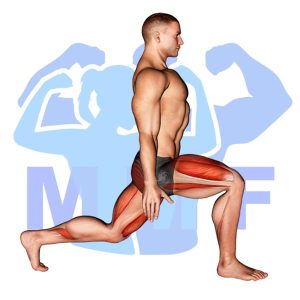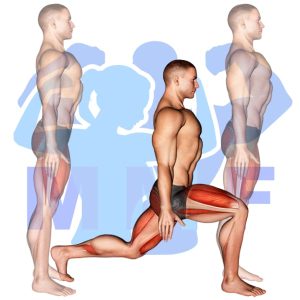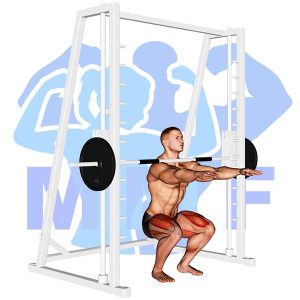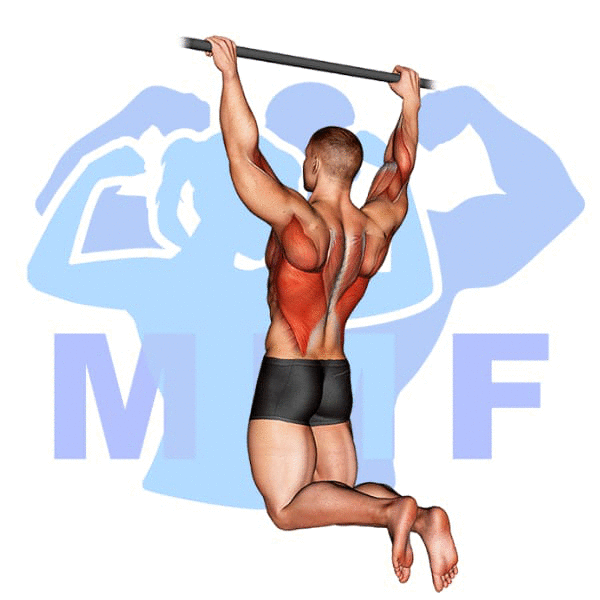Have you ever felt like your lower body workout routine is missing something? Perhaps you’ve hit a plateau and can’t seem to break through to the next level. Or maybe you’re looking for a new exercise that will challenge you both physically and mentally. If any of this resonates with you, the barbell walking lunge might just be the solution you’re looking for. Many people struggle with finding an exercise that engages multiple muscle groups while also promoting cardiovascular endurance. Barbell walking lunges address both of these concerns, making them a valuable addition to any workout routine. In this post, we’ll dive into the benefits of barbell walking lunges and explain how to properly execute the exercise for maximum results.
Barbell Walking Lunge Summary
- Primary Muscles: Gluteus Maximus
- Secondary Muscles: Adductor Magnus, Quadriceps, and Soleus
- Equipment: Barbell
- Mechanics Type: Compound
- Force: Push
- Utility: Basic or Auxiliary

Barbell Walking Lunge Instructions
- Position the barbell on the back of your upper shoulders.
- Keep your feet your hips-width apart for better balance.
- Next, step out with one leg close to twice the length of your normal walking step.
- Then, lunge down bending both knees close to 90°, but don’t let your back leg touch the ground.
- Finally, press up with enough force you can step your back foot forward to a standing position.
- Repeat with your other leg to continue your walking lunges.
Video Tutorial
Barbell Walking Lunge Muscles
Target (Agonist)
Synergists
- Adductor Magnus
- Quadriceps
- Soleus
Dynamic Stabilizers
Stabilizers
- Erector Spinae
- Gluteus Medius
- Gluteus Minimus
- Levator Scapulae
- Obliques
- Quadratus Lumborum
- Tibialis Anterior
- Trapezius – Middle
- Trapezius – Upper
Antagonist Stabilizers
- None

Benefits of Barbell Walking Lunge
The barbell walking lunge is an excellent exercise for targeting the gluteus maximus, the largest muscle in the body. This exercise involves holding a barbell across the shoulders and stepping forward with one leg at a time, engaging the glutes with each lunge. This exercise works the entire lower body and core, building strength and stability as well as aiding in balance. The glutes are used to power the movement and are challenged to work harder as the weight of the barbell increases. By performing barbell walking lunges regularly, you can increase your power, agility, and balance while also strengthening your glutes.
Tips for Performing Barbell Walking Lunge
If you want to add a new exercise to your workout routine and get a great workout at the same time, then the Barbell Walking Lunge is a great option. This exercise targets the glutes, hamstrings, quads, and core, and is a great way to build strength and endurance. To make sure you get the most out of your Barbell Walking Lunge workouts, here are some tips to keep in mind.
- Build Your Form Before You Increase The Load. H correct form will support preventing personal injury and faltering quickly. Excellent Technique can enable you to grow muscle quickly.
- Stay Hydrated. You will recover quicker and a great deal more energy if you intake water while exercising.
- Ensure That You Arrange Rest Days. If you don’t want to recovery you are able to incorporate into your program with aerobic exercise. Only understand to permit your muscles to heal, healing is the only time your muscles grow.
- Perform your major compound exercises near the beginning of your workout, after that perform isolation exercises to target single muscle groups afterward. You really want the optimum capabilities of your individual muscles whenever you do compound exercises including, bench, deadlift, and squats. Next, you want to work the muscle zones of which you identified were weak during those movements, or areas that couldn’t get worked as a result of the type of compound exercise you completed.
Benefits and Tips Video
Frequent Mistakes To Avoid
It’s important to remember that while barbell walking lunges are a great exercise to help you get fit, they can also be dangerous if not done correctly. To ensure your safety, it’s important to be aware of the common mistakes people make when performing this exercise and how to avoid them. Below is a list of the most common mistakes to avoid when doing a barbell walking lunge.
- Avoid The Urge To Skip Out On Recovery Times. Over-training might actually make you less strong in lieu bigger.
- You’ll Do Better To Not Omit Your Cooldown. You can reduce your recuperation time frame and help reduce soreness if you accomplish a proper cool down.
- You Don’t Want To Trai Alone. Your workout partner are generally an amazing motivator. Your training partner can certainly even be helpful spotter.
Find More Barbell Exercises Here
Variations and Complementary Exercises
Once you have mastered the basics of Barbell Walking Lunges, there are a few other exercises that can be used to target similar muscles and increase the intensity of your workout. These variations, complementary, or alternative exercises are listed below.
Dumbbell Lunge

The Dumbbell Lunge is a great alternative or complementary exercise to the Barbell Walking Lunge. It targets the same muscles as the Barbell Walking Lunge, but with a slightly different form. With Dumbbell Lunges, you use two dumbbells instead of a barbell, and you step back with one leg, rather than stepping forward with each leg. This variation emphasizes balance and stability, and allows for a greater range of motion. It also reduces stress on the lower back and hips, making it an ideal exercise for those with injuries or mobility limitations.
Dumbbell Rear Lunge

The Dumbbell Rear Lunge is an excellent complementary or alternative exercise for the Barbell Walking Lunge. This exercise targets the same muscles as the Barbell Walking Lunge, but focuses on the posterior chain of the lower body. It emphasizes the glutes, hamstrings, and calves, and helps to develop lower body strength and power. The Dumbbell Rear Lunge is performed by standing with feet hip-width apart and holding a dumbbell in each hand at the sides of the body. Take a large step backward with one leg and lower the body until both knees are bent at 90 degrees. Push off with the back foot to return to the starting position and repeat on the other side.
Dumbbell Walking Lunges

Dumbbell Walking Lunges are a complementary or alternative exercise for the Barbell Walking Lunge. This exercise requires you to hold a pair of dumbbells and step forward, lowering your body until your back knee almost touches the ground. From this position, you should then push up through your front leg and step forward with the opposite leg, repeating the movement. This exercise is a great way to increase lower body strength and stability, and can be adjusted to increase intensity by increasing the weight of the dumbbells or by taking longer strides.
Check Out These Top Barbell Exercises
Lunge

The Lunge is an excellent complimentary or alternative exercise for the Barbell Walking Lunge. It is an effective lower body exercise that targets the glutes, quadriceps and hamstrings. The Lunge can also be performed using a variety of equipment including dumbbells, barbells, and kettlebells. This exercise can be done with a forward, reverse, or lateral movement depending on the desired outcome. The Lunge is great for building strength and stability in the legs and core, as well as improving balance and coordination. For those looking to add variety to their workout routine, the Lunge is an excellent choice.
Rear Lunge

Rear Lunge is a great complementary or alternative exercise to Barbell Walking Lunge. This exercise focuses on the posterior muscles, such as the glutes and hamstrings, and can be done with or without weights. To perform this exercise, stand with your feet hip-width apart and step one foot backward into a lunge position. Make sure your front knee is bent at a 90 degree angle and your back knee is close to the ground. Push off your front foot to return to the starting position and then switch sides. Rear Lunge is great for increasing lower body strength and stability, which makes it an ideal complement to Barbell Walking Lunge.
Walking Lunge

Walking Lunges are a great complementary or alternative exercise to the Barbell Walking Lunge. This exercise works the same muscle groups as the Barbell Walking Lunge, but with a different range of motion. The Walking Lunge focuses on the quads, hamstrings, glutes and core, while also working the stabilizer muscles in the lower body. The exercise can be done with or without weights and can be done in multiple directions, adding variety to your routine. It is an effective exercise for improving balance and stability while also increasing muscular strength and endurance.
Find More Glutes Exercises Here
Opposing Complementary Exercises
To further complement the exercise Barbell Walking Lunge, you can also add exercises that work opposing muscle groups. These exercises will help to create balance and stability throughout your body, which will lead to better overall performance in the lunge exercise. Below is a list of exercises that you can use to further strengthen the opposite muscles used in the Barbell Walking Lunge.
Smith Machine Clean Grip Front Squat

The Smith Machine Clean Grip Front Squat is an excellent complementary exercise to the Barbell Walking Lunge. It works the opposing muscle group of the quads, the hamstrings, by performing a deep squatting motion. This exercise is beneficial for strengthening the posterior chain and stabilizing the hips, which is key for executing proper form during Barbell Walking Lunges. The Smith Machine Clean Grip Front Squat also helps build strength and power in the lower body, allowing for greater performance during the Barbell Walking Lunge.
Smith Machine Frankenstein Squat

The Smith Machine Frankenstein Squat is a great exercise to complement the Barbell Walking Lunge. This exercise works the opposite muscle group of the Barbell Walking Lunge, focusing on the glutes and hamstrings. The Smith Machine Frankenstein Squat is an excellent way to target the lower body and work both the quads and hamstrings. It helps to build strength, stability, and balance in the lower body, which helps to support and enhance the effects of the Barbell Walking Lunge. Additionally, it can be used as a warm-up or cool down exercise to help promote better form and technique during the Barbell Walking Lunge.
Smith Machine Front Squat

The Smith Machine Front Squat is an excellent exercise to pair with the Barbell Walking Lunge as it works the opposite muscle group. It is a great way to build strength in the lower body as it targets the quads and glutes in a unique way. The Smith Machine allows for a deeper range of motion and more stability than a regular squat, making it a great choice for those looking to improve their form and power. Furthermore, the Smith Machine allows for a greater degree of control over the weight, which makes it easier to progress as you become stronger. The Barbell Walking Lunge, on the other hand, works the hamstrings, glutes, and core, making it a complementary exercise to the Smith Machine Front Squat. Together they make an excellent combination to strengthen and tone the lower body.
Level Up Your Leg Day with Barbell Walking Lunges
Are you ready to take your leg day to the next level? Look no further than barbell walking lunges. This exercise not only targets your quads, hamstrings, and glutes, but also improves hip stability and balance. By adding weight through a barbell, you increase the intensity and challenge for your muscles. Plus, by walking instead of staying stationary, you engage your stabilizer muscles even more. Don’t be intimidated to try this exercise – start with a lighter weight and focus on proper form, and you’ll be on your way to stronger legs in no time.
References: Wikipedia | ExRx.net | PubMed.gov | Comprehensive List of Glutes Barbell Exercises




